Altruism: A Psychological Examination of Self-Sacrificial Behavior
VerifiedAdded on 2022/11/22
|7
|1983
|192
Essay
AI Summary
This essay delves into the concept of altruism, questioning whether the human mind is inherently designed for self-sacrifice. It explores two primary theories: Kin Selection Theory, which emphasizes genetic relatedness and innate behaviors, and Empathy-Altruism Theory, which highlights the role of human emotion and conscious effort in helping others. The essay examines the limitations of both theories, considering factors such as non-kin altruism, the complexities of empathy, and the potential for selfish motives underlying seemingly altruistic acts. It analyzes the role of empathy, perspective-taking, and the influence of personal experiences on altruistic behavior. The essay concludes that while humans exhibit altruistic tendencies, the motivations are complex and often influenced by a combination of genetic predisposition, emotional responses, and self-interest. It emphasizes that self-sacrificial behavior is not always purely altruistic, as motives may exist.
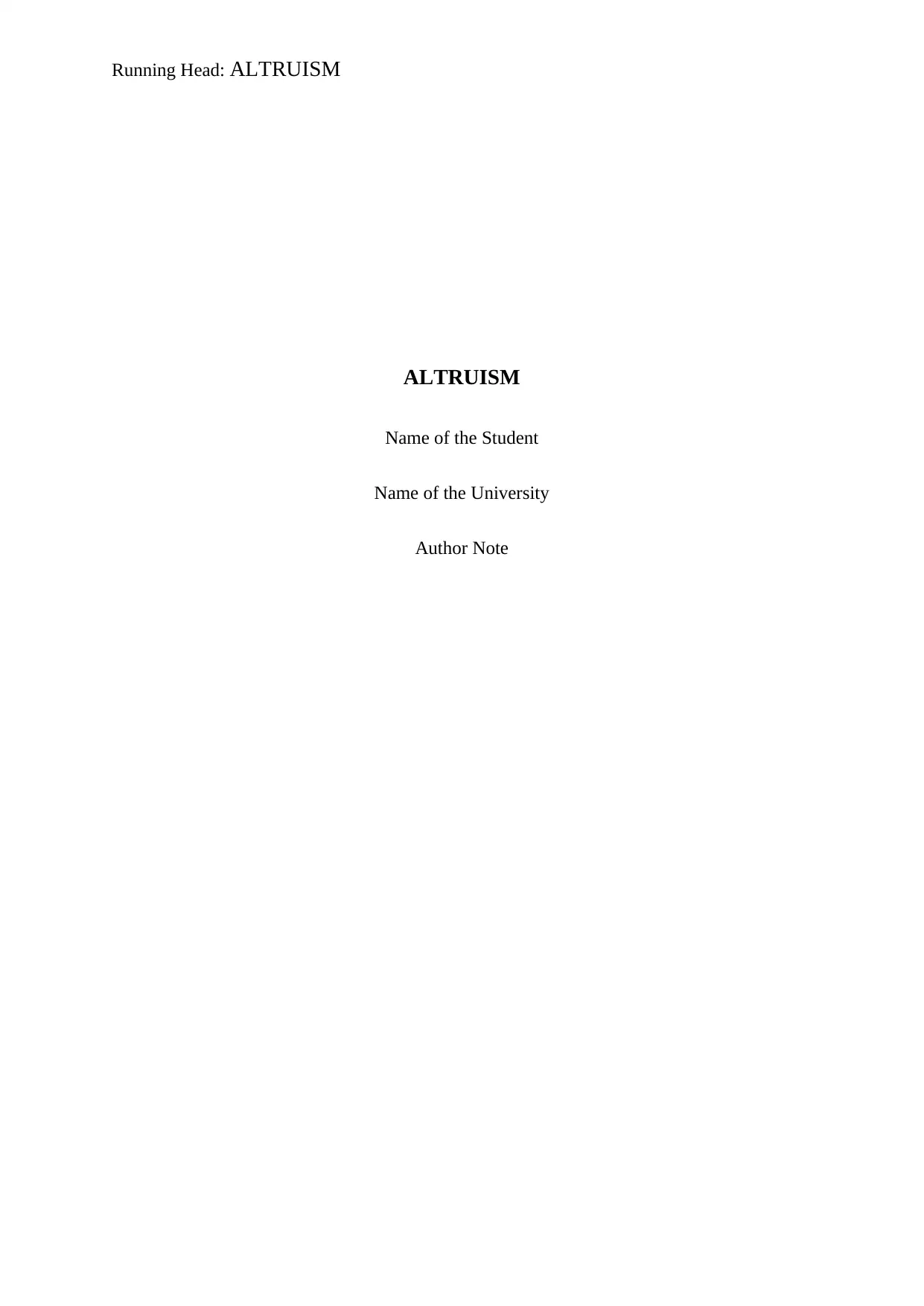
Running Head: ALTRUISM
ALTRUISM
Name of the Student
Name of the University
Author Note
ALTRUISM
Name of the Student
Name of the University
Author Note
Paraphrase This Document
Need a fresh take? Get an instant paraphrase of this document with our AI Paraphraser
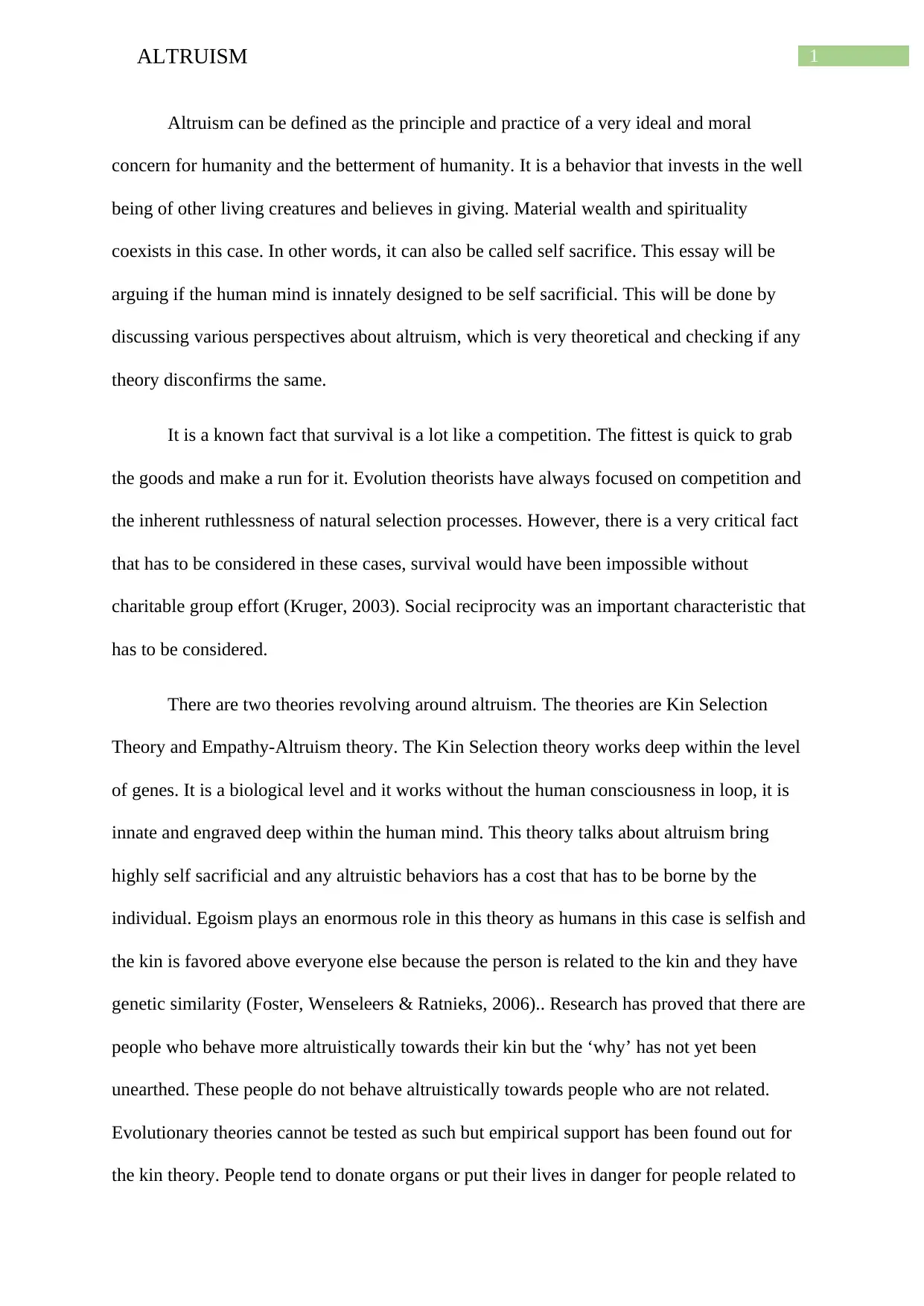
1ALTRUISM
Altruism can be defined as the principle and practice of a very ideal and moral
concern for humanity and the betterment of humanity. It is a behavior that invests in the well
being of other living creatures and believes in giving. Material wealth and spirituality
coexists in this case. In other words, it can also be called self sacrifice. This essay will be
arguing if the human mind is innately designed to be self sacrificial. This will be done by
discussing various perspectives about altruism, which is very theoretical and checking if any
theory disconfirms the same.
It is a known fact that survival is a lot like a competition. The fittest is quick to grab
the goods and make a run for it. Evolution theorists have always focused on competition and
the inherent ruthlessness of natural selection processes. However, there is a very critical fact
that has to be considered in these cases, survival would have been impossible without
charitable group effort (Kruger, 2003). Social reciprocity was an important characteristic that
has to be considered.
There are two theories revolving around altruism. The theories are Kin Selection
Theory and Empathy-Altruism theory. The Kin Selection theory works deep within the level
of genes. It is a biological level and it works without the human consciousness in loop, it is
innate and engraved deep within the human mind. This theory talks about altruism bring
highly self sacrificial and any altruistic behaviors has a cost that has to be borne by the
individual. Egoism plays an enormous role in this theory as humans in this case is selfish and
the kin is favored above everyone else because the person is related to the kin and they have
genetic similarity (Foster, Wenseleers & Ratnieks, 2006).. Research has proved that there are
people who behave more altruistically towards their kin but the ‘why’ has not yet been
unearthed. These people do not behave altruistically towards people who are not related.
Evolutionary theories cannot be tested as such but empirical support has been found out for
the kin theory. People tend to donate organs or put their lives in danger for people related to
Altruism can be defined as the principle and practice of a very ideal and moral
concern for humanity and the betterment of humanity. It is a behavior that invests in the well
being of other living creatures and believes in giving. Material wealth and spirituality
coexists in this case. In other words, it can also be called self sacrifice. This essay will be
arguing if the human mind is innately designed to be self sacrificial. This will be done by
discussing various perspectives about altruism, which is very theoretical and checking if any
theory disconfirms the same.
It is a known fact that survival is a lot like a competition. The fittest is quick to grab
the goods and make a run for it. Evolution theorists have always focused on competition and
the inherent ruthlessness of natural selection processes. However, there is a very critical fact
that has to be considered in these cases, survival would have been impossible without
charitable group effort (Kruger, 2003). Social reciprocity was an important characteristic that
has to be considered.
There are two theories revolving around altruism. The theories are Kin Selection
Theory and Empathy-Altruism theory. The Kin Selection theory works deep within the level
of genes. It is a biological level and it works without the human consciousness in loop, it is
innate and engraved deep within the human mind. This theory talks about altruism bring
highly self sacrificial and any altruistic behaviors has a cost that has to be borne by the
individual. Egoism plays an enormous role in this theory as humans in this case is selfish and
the kin is favored above everyone else because the person is related to the kin and they have
genetic similarity (Foster, Wenseleers & Ratnieks, 2006).. Research has proved that there are
people who behave more altruistically towards their kin but the ‘why’ has not yet been
unearthed. These people do not behave altruistically towards people who are not related.
Evolutionary theories cannot be tested as such but empirical support has been found out for
the kin theory. People tend to donate organs or put their lives in danger for people related to
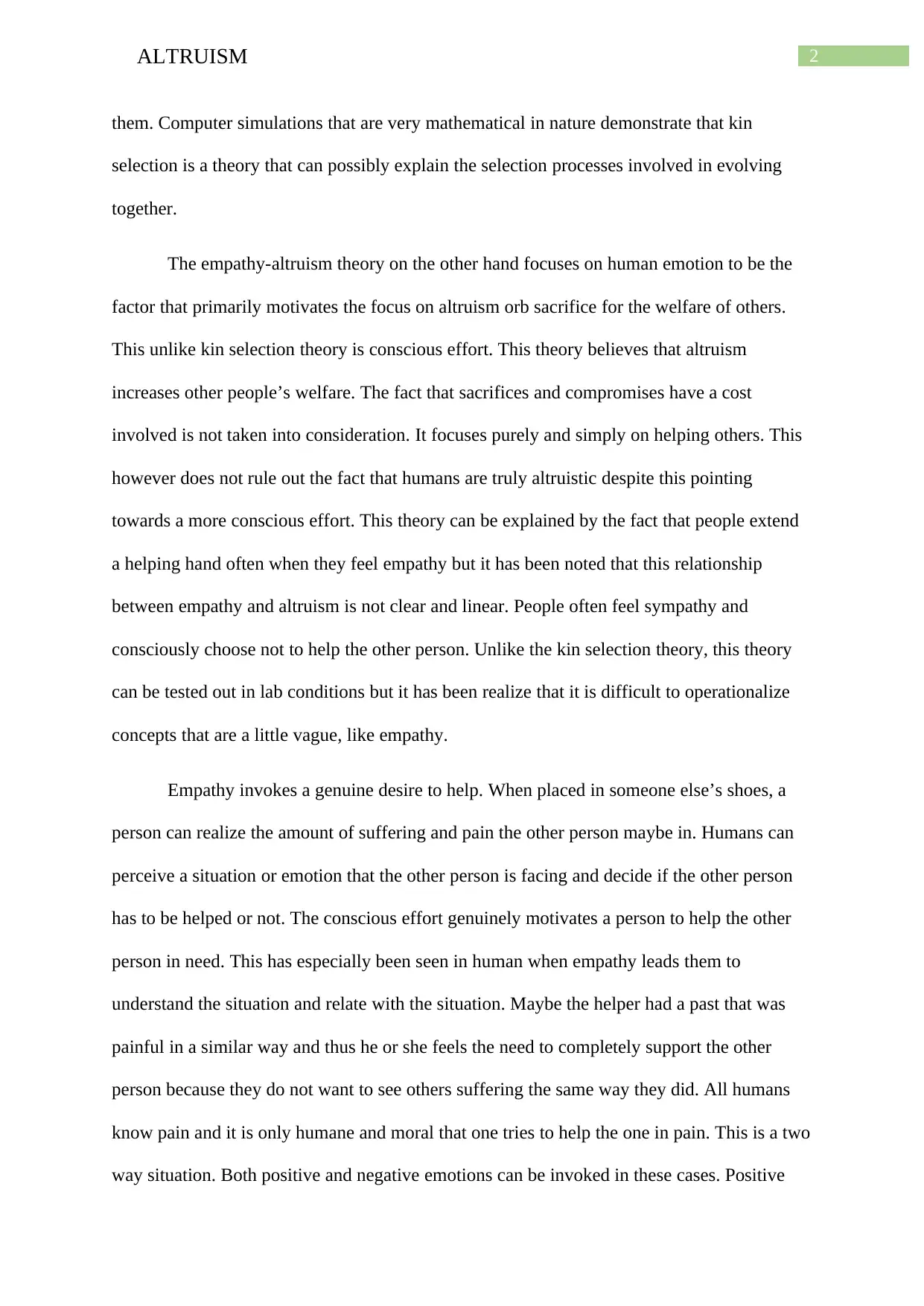
2ALTRUISM
them. Computer simulations that are very mathematical in nature demonstrate that kin
selection is a theory that can possibly explain the selection processes involved in evolving
together.
The empathy-altruism theory on the other hand focuses on human emotion to be the
factor that primarily motivates the focus on altruism orb sacrifice for the welfare of others.
This unlike kin selection theory is conscious effort. This theory believes that altruism
increases other people’s welfare. The fact that sacrifices and compromises have a cost
involved is not taken into consideration. It focuses purely and simply on helping others. This
however does not rule out the fact that humans are truly altruistic despite this pointing
towards a more conscious effort. This theory can be explained by the fact that people extend
a helping hand often when they feel empathy but it has been noted that this relationship
between empathy and altruism is not clear and linear. People often feel sympathy and
consciously choose not to help the other person. Unlike the kin selection theory, this theory
can be tested out in lab conditions but it has been realize that it is difficult to operationalize
concepts that are a little vague, like empathy.
Empathy invokes a genuine desire to help. When placed in someone else’s shoes, a
person can realize the amount of suffering and pain the other person maybe in. Humans can
perceive a situation or emotion that the other person is facing and decide if the other person
has to be helped or not. The conscious effort genuinely motivates a person to help the other
person in need. This has especially been seen in human when empathy leads them to
understand the situation and relate with the situation. Maybe the helper had a past that was
painful in a similar way and thus he or she feels the need to completely support the other
person because they do not want to see others suffering the same way they did. All humans
know pain and it is only humane and moral that one tries to help the one in pain. This is a two
way situation. Both positive and negative emotions can be invoked in these cases. Positive
them. Computer simulations that are very mathematical in nature demonstrate that kin
selection is a theory that can possibly explain the selection processes involved in evolving
together.
The empathy-altruism theory on the other hand focuses on human emotion to be the
factor that primarily motivates the focus on altruism orb sacrifice for the welfare of others.
This unlike kin selection theory is conscious effort. This theory believes that altruism
increases other people’s welfare. The fact that sacrifices and compromises have a cost
involved is not taken into consideration. It focuses purely and simply on helping others. This
however does not rule out the fact that humans are truly altruistic despite this pointing
towards a more conscious effort. This theory can be explained by the fact that people extend
a helping hand often when they feel empathy but it has been noted that this relationship
between empathy and altruism is not clear and linear. People often feel sympathy and
consciously choose not to help the other person. Unlike the kin selection theory, this theory
can be tested out in lab conditions but it has been realize that it is difficult to operationalize
concepts that are a little vague, like empathy.
Empathy invokes a genuine desire to help. When placed in someone else’s shoes, a
person can realize the amount of suffering and pain the other person maybe in. Humans can
perceive a situation or emotion that the other person is facing and decide if the other person
has to be helped or not. The conscious effort genuinely motivates a person to help the other
person in need. This has especially been seen in human when empathy leads them to
understand the situation and relate with the situation. Maybe the helper had a past that was
painful in a similar way and thus he or she feels the need to completely support the other
person because they do not want to see others suffering the same way they did. All humans
know pain and it is only humane and moral that one tries to help the one in pain. This is a two
way situation. Both positive and negative emotions can be invoked in these cases. Positive
⊘ This is a preview!⊘
Do you want full access?
Subscribe today to unlock all pages.

Trusted by 1+ million students worldwide
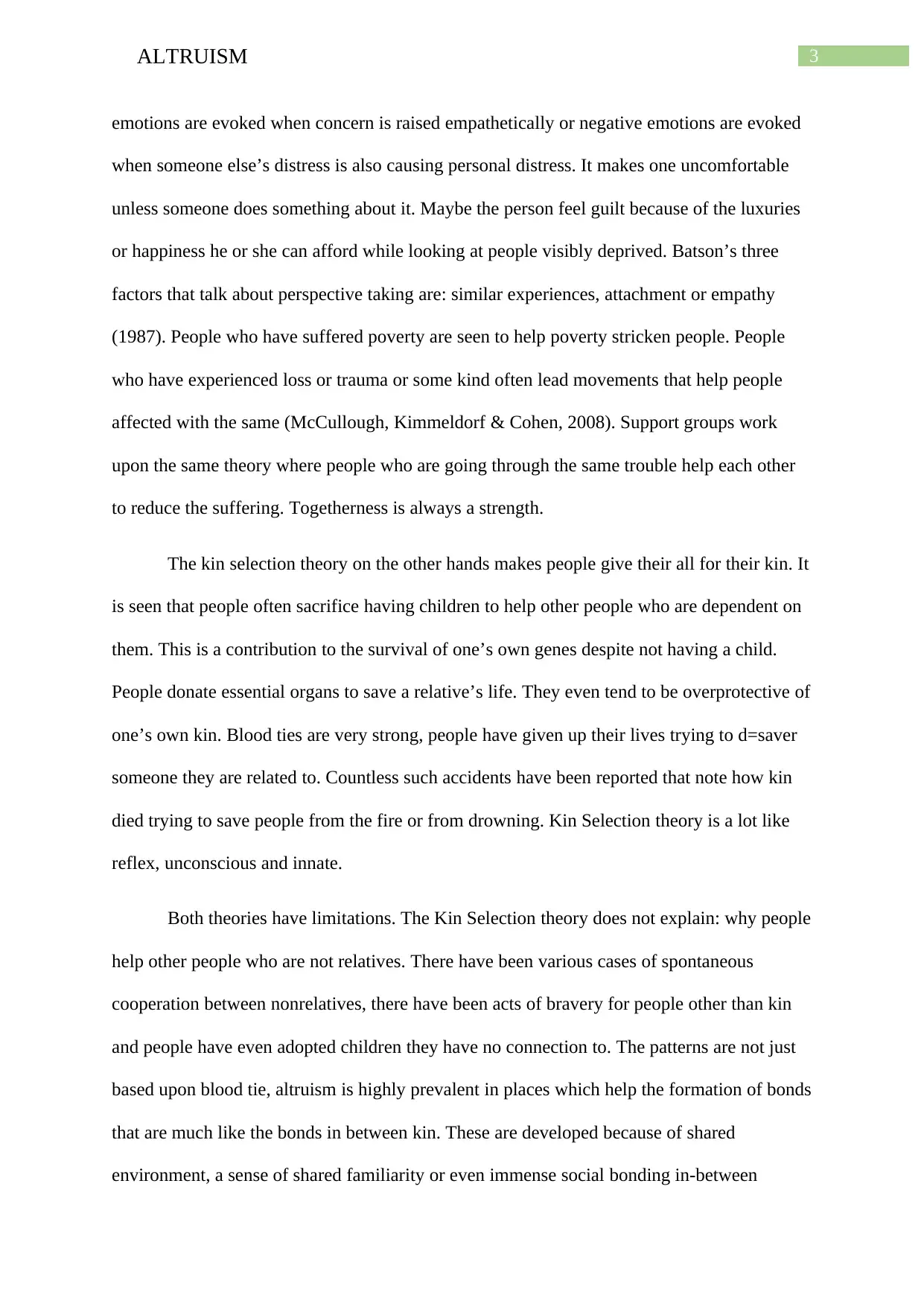
3ALTRUISM
emotions are evoked when concern is raised empathetically or negative emotions are evoked
when someone else’s distress is also causing personal distress. It makes one uncomfortable
unless someone does something about it. Maybe the person feel guilt because of the luxuries
or happiness he or she can afford while looking at people visibly deprived. Batson’s three
factors that talk about perspective taking are: similar experiences, attachment or empathy
(1987). People who have suffered poverty are seen to help poverty stricken people. People
who have experienced loss or trauma or some kind often lead movements that help people
affected with the same (McCullough, Kimmeldorf & Cohen, 2008). Support groups work
upon the same theory where people who are going through the same trouble help each other
to reduce the suffering. Togetherness is always a strength.
The kin selection theory on the other hands makes people give their all for their kin. It
is seen that people often sacrifice having children to help other people who are dependent on
them. This is a contribution to the survival of one’s own genes despite not having a child.
People donate essential organs to save a relative’s life. They even tend to be overprotective of
one’s own kin. Blood ties are very strong, people have given up their lives trying to d=saver
someone they are related to. Countless such accidents have been reported that note how kin
died trying to save people from the fire or from drowning. Kin Selection theory is a lot like
reflex, unconscious and innate.
Both theories have limitations. The Kin Selection theory does not explain: why people
help other people who are not relatives. There have been various cases of spontaneous
cooperation between nonrelatives, there have been acts of bravery for people other than kin
and people have even adopted children they have no connection to. The patterns are not just
based upon blood tie, altruism is highly prevalent in places which help the formation of bonds
that are much like the bonds in between kin. These are developed because of shared
environment, a sense of shared familiarity or even immense social bonding in-between
emotions are evoked when concern is raised empathetically or negative emotions are evoked
when someone else’s distress is also causing personal distress. It makes one uncomfortable
unless someone does something about it. Maybe the person feel guilt because of the luxuries
or happiness he or she can afford while looking at people visibly deprived. Batson’s three
factors that talk about perspective taking are: similar experiences, attachment or empathy
(1987). People who have suffered poverty are seen to help poverty stricken people. People
who have experienced loss or trauma or some kind often lead movements that help people
affected with the same (McCullough, Kimmeldorf & Cohen, 2008). Support groups work
upon the same theory where people who are going through the same trouble help each other
to reduce the suffering. Togetherness is always a strength.
The kin selection theory on the other hands makes people give their all for their kin. It
is seen that people often sacrifice having children to help other people who are dependent on
them. This is a contribution to the survival of one’s own genes despite not having a child.
People donate essential organs to save a relative’s life. They even tend to be overprotective of
one’s own kin. Blood ties are very strong, people have given up their lives trying to d=saver
someone they are related to. Countless such accidents have been reported that note how kin
died trying to save people from the fire or from drowning. Kin Selection theory is a lot like
reflex, unconscious and innate.
Both theories have limitations. The Kin Selection theory does not explain: why people
help other people who are not relatives. There have been various cases of spontaneous
cooperation between nonrelatives, there have been acts of bravery for people other than kin
and people have even adopted children they have no connection to. The patterns are not just
based upon blood tie, altruism is highly prevalent in places which help the formation of bonds
that are much like the bonds in between kin. These are developed because of shared
environment, a sense of shared familiarity or even immense social bonding in-between
Paraphrase This Document
Need a fresh take? Get an instant paraphrase of this document with our AI Paraphraser
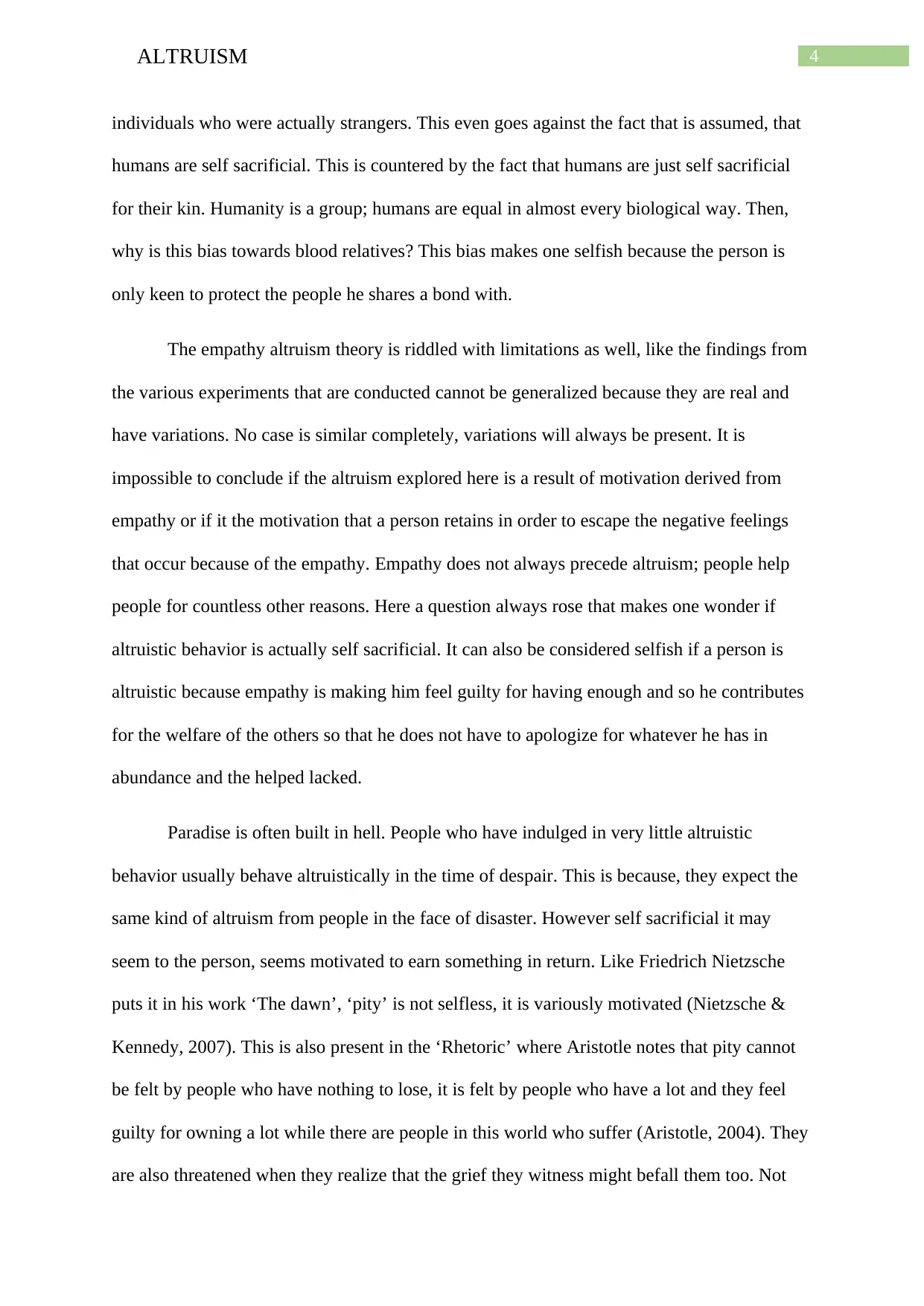
4ALTRUISM
individuals who were actually strangers. This even goes against the fact that is assumed, that
humans are self sacrificial. This is countered by the fact that humans are just self sacrificial
for their kin. Humanity is a group; humans are equal in almost every biological way. Then,
why is this bias towards blood relatives? This bias makes one selfish because the person is
only keen to protect the people he shares a bond with.
The empathy altruism theory is riddled with limitations as well, like the findings from
the various experiments that are conducted cannot be generalized because they are real and
have variations. No case is similar completely, variations will always be present. It is
impossible to conclude if the altruism explored here is a result of motivation derived from
empathy or if it the motivation that a person retains in order to escape the negative feelings
that occur because of the empathy. Empathy does not always precede altruism; people help
people for countless other reasons. Here a question always rose that makes one wonder if
altruistic behavior is actually self sacrificial. It can also be considered selfish if a person is
altruistic because empathy is making him feel guilty for having enough and so he contributes
for the welfare of the others so that he does not have to apologize for whatever he has in
abundance and the helped lacked.
Paradise is often built in hell. People who have indulged in very little altruistic
behavior usually behave altruistically in the time of despair. This is because, they expect the
same kind of altruism from people in the face of disaster. However self sacrificial it may
seem to the person, seems motivated to earn something in return. Like Friedrich Nietzsche
puts it in his work ‘The dawn’, ‘pity’ is not selfless, it is variously motivated (Nietzsche &
Kennedy, 2007). This is also present in the ‘Rhetoric’ where Aristotle notes that pity cannot
be felt by people who have nothing to lose, it is felt by people who have a lot and they feel
guilty for owning a lot while there are people in this world who suffer (Aristotle, 2004). They
are also threatened when they realize that the grief they witness might befall them too. Not
individuals who were actually strangers. This even goes against the fact that is assumed, that
humans are self sacrificial. This is countered by the fact that humans are just self sacrificial
for their kin. Humanity is a group; humans are equal in almost every biological way. Then,
why is this bias towards blood relatives? This bias makes one selfish because the person is
only keen to protect the people he shares a bond with.
The empathy altruism theory is riddled with limitations as well, like the findings from
the various experiments that are conducted cannot be generalized because they are real and
have variations. No case is similar completely, variations will always be present. It is
impossible to conclude if the altruism explored here is a result of motivation derived from
empathy or if it the motivation that a person retains in order to escape the negative feelings
that occur because of the empathy. Empathy does not always precede altruism; people help
people for countless other reasons. Here a question always rose that makes one wonder if
altruistic behavior is actually self sacrificial. It can also be considered selfish if a person is
altruistic because empathy is making him feel guilty for having enough and so he contributes
for the welfare of the others so that he does not have to apologize for whatever he has in
abundance and the helped lacked.
Paradise is often built in hell. People who have indulged in very little altruistic
behavior usually behave altruistically in the time of despair. This is because, they expect the
same kind of altruism from people in the face of disaster. However self sacrificial it may
seem to the person, seems motivated to earn something in return. Like Friedrich Nietzsche
puts it in his work ‘The dawn’, ‘pity’ is not selfless, it is variously motivated (Nietzsche &
Kennedy, 2007). This is also present in the ‘Rhetoric’ where Aristotle notes that pity cannot
be felt by people who have nothing to lose, it is felt by people who have a lot and they feel
guilty for owning a lot while there are people in this world who suffer (Aristotle, 2004). They
are also threatened when they realize that the grief they witness might befall them too. Not
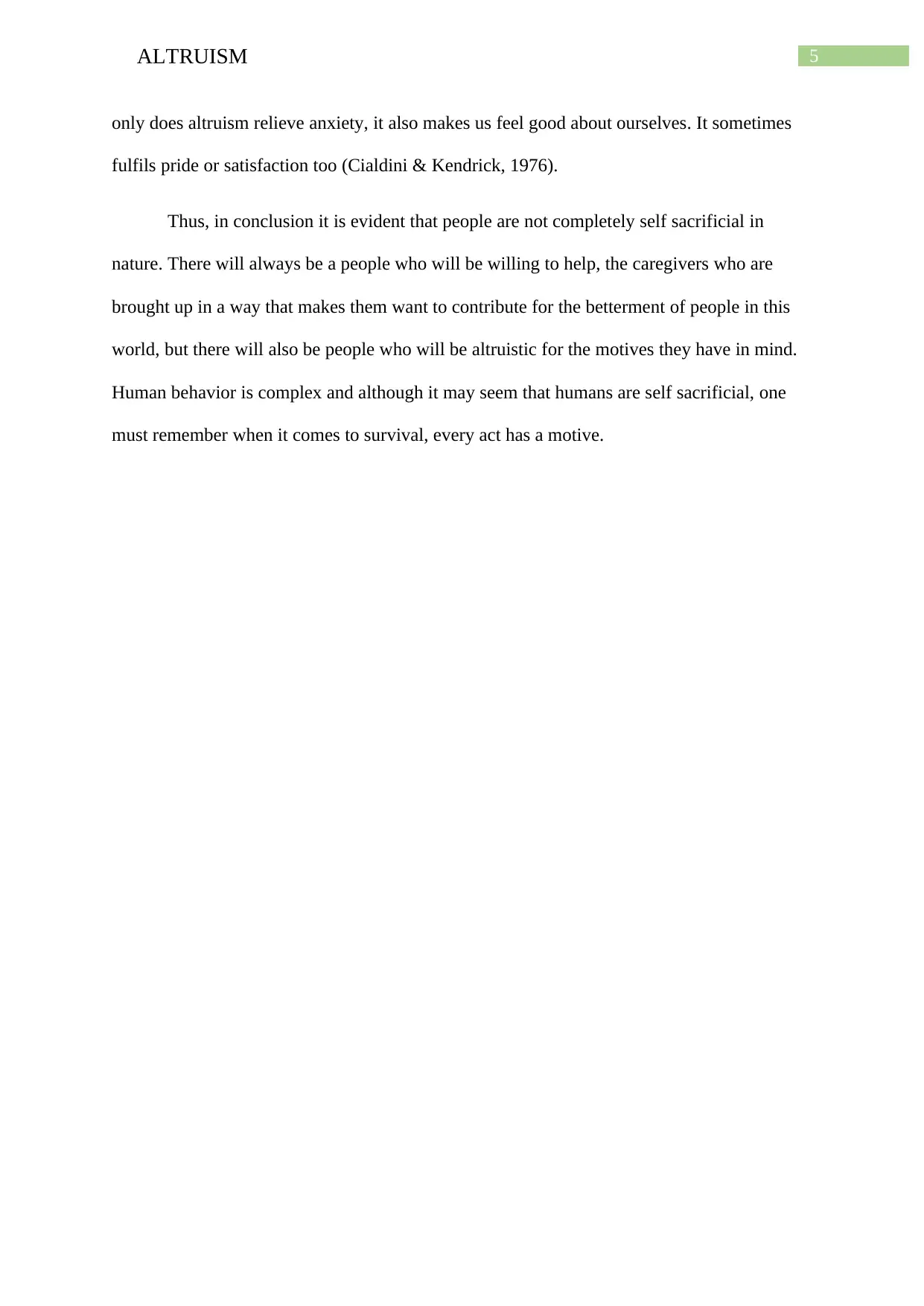
5ALTRUISM
only does altruism relieve anxiety, it also makes us feel good about ourselves. It sometimes
fulfils pride or satisfaction too (Cialdini & Kendrick, 1976).
Thus, in conclusion it is evident that people are not completely self sacrificial in
nature. There will always be a people who will be willing to help, the caregivers who are
brought up in a way that makes them want to contribute for the betterment of people in this
world, but there will also be people who will be altruistic for the motives they have in mind.
Human behavior is complex and although it may seem that humans are self sacrificial, one
must remember when it comes to survival, every act has a motive.
only does altruism relieve anxiety, it also makes us feel good about ourselves. It sometimes
fulfils pride or satisfaction too (Cialdini & Kendrick, 1976).
Thus, in conclusion it is evident that people are not completely self sacrificial in
nature. There will always be a people who will be willing to help, the caregivers who are
brought up in a way that makes them want to contribute for the betterment of people in this
world, but there will also be people who will be altruistic for the motives they have in mind.
Human behavior is complex and although it may seem that humans are self sacrificial, one
must remember when it comes to survival, every act has a motive.
⊘ This is a preview!⊘
Do you want full access?
Subscribe today to unlock all pages.

Trusted by 1+ million students worldwide
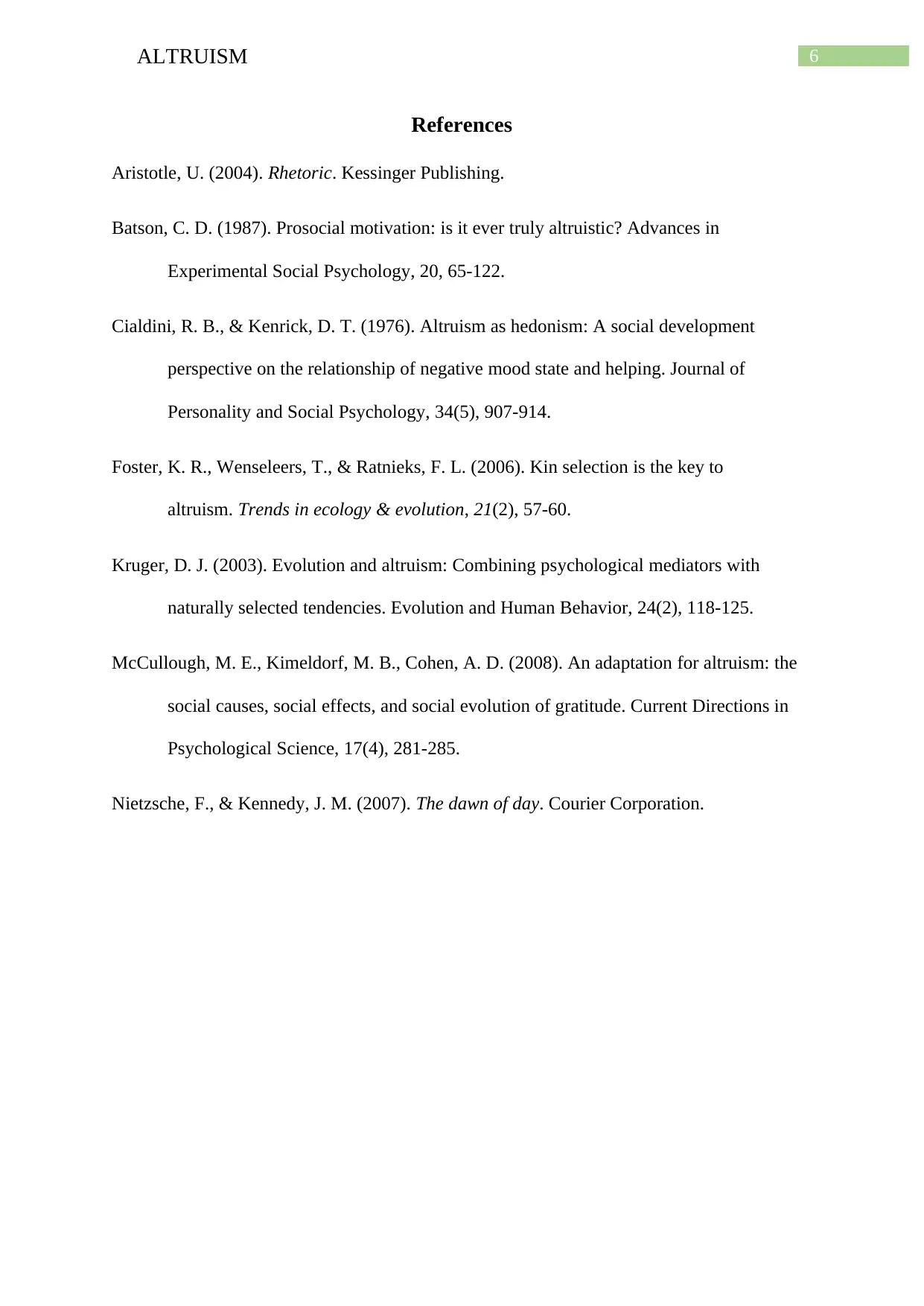
6ALTRUISM
References
Aristotle, U. (2004). Rhetoric. Kessinger Publishing.
Batson, C. D. (1987). Prosocial motivation: is it ever truly altruistic? Advances in
Experimental Social Psychology, 20, 65-122.
Cialdini, R. B., & Kenrick, D. T. (1976). Altruism as hedonism: A social development
perspective on the relationship of negative mood state and helping. Journal of
Personality and Social Psychology, 34(5), 907-914.
Foster, K. R., Wenseleers, T., & Ratnieks, F. L. (2006). Kin selection is the key to
altruism. Trends in ecology & evolution, 21(2), 57-60.
Kruger, D. J. (2003). Evolution and altruism: Combining psychological mediators with
naturally selected tendencies. Evolution and Human Behavior, 24(2), 118-125.
McCullough, M. E., Kimeldorf, M. B., Cohen, A. D. (2008). An adaptation for altruism: the
social causes, social effects, and social evolution of gratitude. Current Directions in
Psychological Science, 17(4), 281-285.
Nietzsche, F., & Kennedy, J. M. (2007). The dawn of day. Courier Corporation.
References
Aristotle, U. (2004). Rhetoric. Kessinger Publishing.
Batson, C. D. (1987). Prosocial motivation: is it ever truly altruistic? Advances in
Experimental Social Psychology, 20, 65-122.
Cialdini, R. B., & Kenrick, D. T. (1976). Altruism as hedonism: A social development
perspective on the relationship of negative mood state and helping. Journal of
Personality and Social Psychology, 34(5), 907-914.
Foster, K. R., Wenseleers, T., & Ratnieks, F. L. (2006). Kin selection is the key to
altruism. Trends in ecology & evolution, 21(2), 57-60.
Kruger, D. J. (2003). Evolution and altruism: Combining psychological mediators with
naturally selected tendencies. Evolution and Human Behavior, 24(2), 118-125.
McCullough, M. E., Kimeldorf, M. B., Cohen, A. D. (2008). An adaptation for altruism: the
social causes, social effects, and social evolution of gratitude. Current Directions in
Psychological Science, 17(4), 281-285.
Nietzsche, F., & Kennedy, J. M. (2007). The dawn of day. Courier Corporation.
1 out of 7
Related Documents
Your All-in-One AI-Powered Toolkit for Academic Success.
+13062052269
info@desklib.com
Available 24*7 on WhatsApp / Email
![[object Object]](/_next/static/media/star-bottom.7253800d.svg)
Unlock your academic potential
Copyright © 2020–2025 A2Z Services. All Rights Reserved. Developed and managed by ZUCOL.





